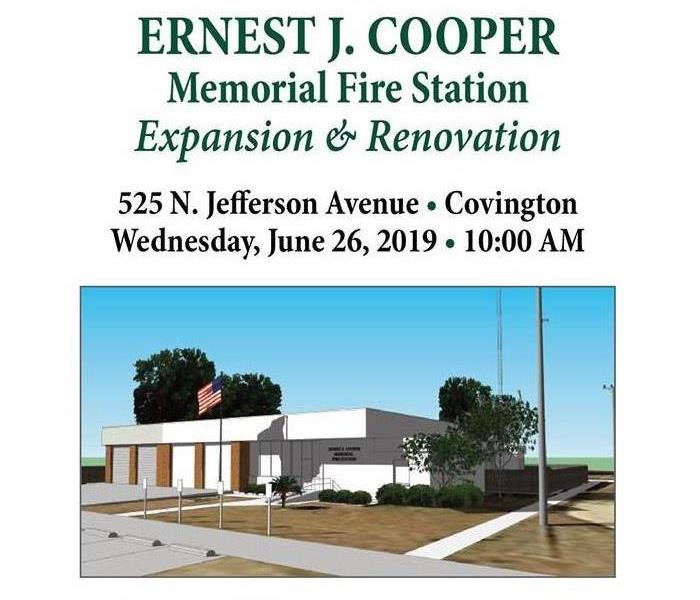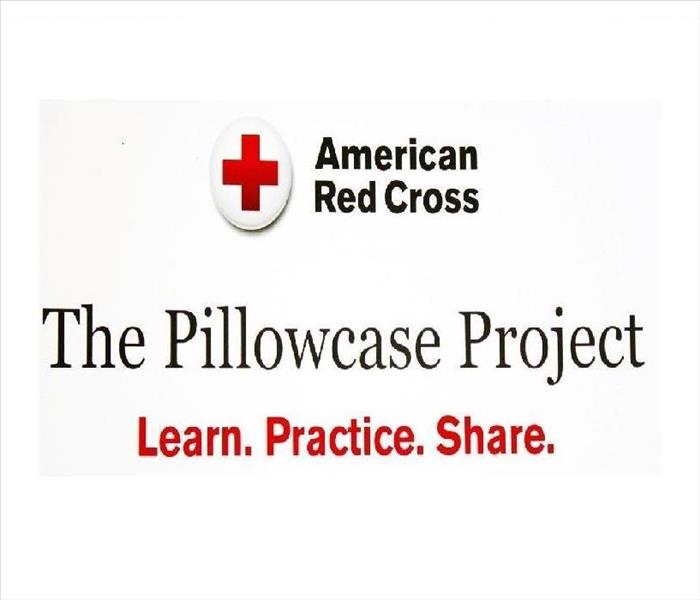Recent Fire Damage Posts
Putting a fire out: The PASS Method
8/18/2023 (Permalink)
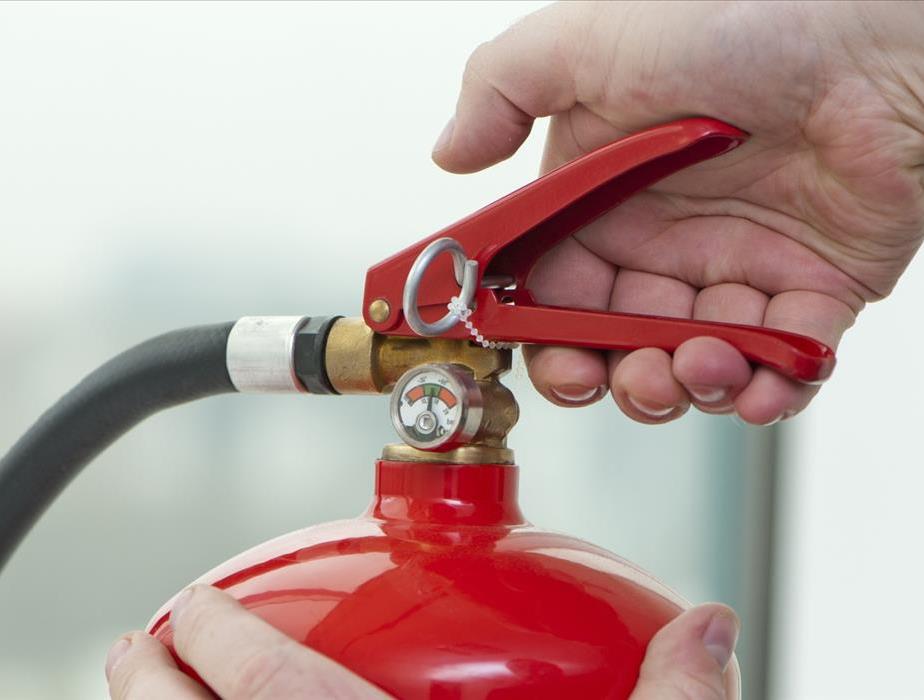 The PASS Method is easy and affective.
The PASS Method is easy and affective.
According to the National Fire Protection Association’s Home Structure Fires report more than 26% of reported fires from 2016-2020 occurred in a home and 75% of civilian fire deaths are caused by home fires. Most of these tragic disasters start from cooking, heating equipment, electrical issues, and lighting failures. Being confident and prepared for a home fire can make the difference in life and death. One small but highly effective way to be prepared for a fire is having the proper knowledge of how to put a fire out. The PASS method was created to help simplify the use of a fire extinguisher.
Pull – Maintaining control of the nozzle, pull the pin at the top of the extinguisher.
Aim – Stand back from the flames. With one hand, aim the nozzle at the base of the fire.
Squeeze – Firmly squeeze the nozzle with your hand.
Sweep – Quickly contain the fire by making a sweeping motion with the nozzle.
Now even though a fire extinguisher can be effective it is important to only use it for smaller fires. NEVER take it upon yourself to put out a large fire. If a fire seems too massive and dangerous it is always best to call your local fire department. It is never worth taking the risk when you are one phone call away from having professional help.
After a fire is extinguished and everyone is safe, our SERVPRO of Greater Covington and Mandeville team is ready to help with cleanup and restoration. We have trained and certified technicians that can make the fore “Like it never happened.” Contact our office with more information.
How to Protect Your Home from Lightning-Related Fires
7/26/2022 (Permalink)
Lightning is hotter than the sun and can reach temperatures of 50,000 degrees Fahrenheit. Lightning-related fires most often occur during the summer storm season, typically months June through August. However, lightning-related fires do happen all year long and in every state. According to NFPA’s latest report “Lightning Fires and Lightning Strikes”, during 2007-2011, U.S. local fire departments responded to an estimated 22,600 fires per year caused by lightning strikes. While this data includes both structure and non-structure fires, nineteen percent of lightning fires were home fires.
Recent insurance claims data from the Insurance Information Institute reveals Louisiana is ranked the eighth state in homeowners’ lightning loss claims for 2021. In Louisiana, there were 2,372 homeowners claims due to lightning in 2021 which resulted in over twenty-eight million dollars in damages. Thankfully, there are ways to protect your home from lightning-related fires and to mitigate damages.
Prevent Lightning-Related Fires by Installing a Whole-house Lightning Protection System
Lightning protection systems work to intercept lightning strikes, provide a conductive path for the electrical discharge to follow, and safely disperse the energy into the ground.
A whole-home lightning protection system consists of:
- Air terminals (a.k.a. lightning rods) mounted on the roof
- Main conductors made of aluminum or copper wires to redirect electricity
- A proper grounding system
- A bonding system to prevent sparks or side flashes
- Surge protective devices
Lightning protection systems should follow the national standards and requirements of the Lightning Protection Institute, National Fire Protection Association, and Underwriters Laboratories. Only experienced and reputable lightning protection contractors listed by Underwriters Laboratories and certified by Lightning Protection Institute should install these systems.
Prevent Lightning-Related Fire by Removing Yard Debris
Dry grass, plants, and leaves are highly flammable and should be regularly removed from your yard to prevent a ground fire from spreading to the home.
Prevent Lightning-Related Fires by Updating Wiring in Older Homes
Older homes can often experience electrical problems. Consult with a qualified electrician to inspect your home’s electrical and grounding systems. Without a proper grounding system, a lightning strike could cause a fire and affect your home’s electrical foundation.
How to Respond to a Lightning-Related Home Fire
If a lightning strike causes your home to catch on fire, your family’s safety is the top priority. Everyone must exit the home immediately. Once in a safe location far away from your home, call the fire department for help. Do not reenter your home until you are told it is safe.
After the fire is extinguished, limit movement in your home to prevent further damage. Do not try to clean soot or fire damage yourself without proper personal protective equipment. Fire damage cleaning and restoration are best left to trained professionals.
SERVPRO of Greater Covington and Mandeville’s certified and experienced fire restoration professionals are here to help 24-7-365. To learn more about our fire damage restoration services or to schedule an inspection, call our office by dialing 985-871-5375.
3 Common Causes of Commercial Fires and Tips to Prevent Them
6/9/2022 (Permalink)
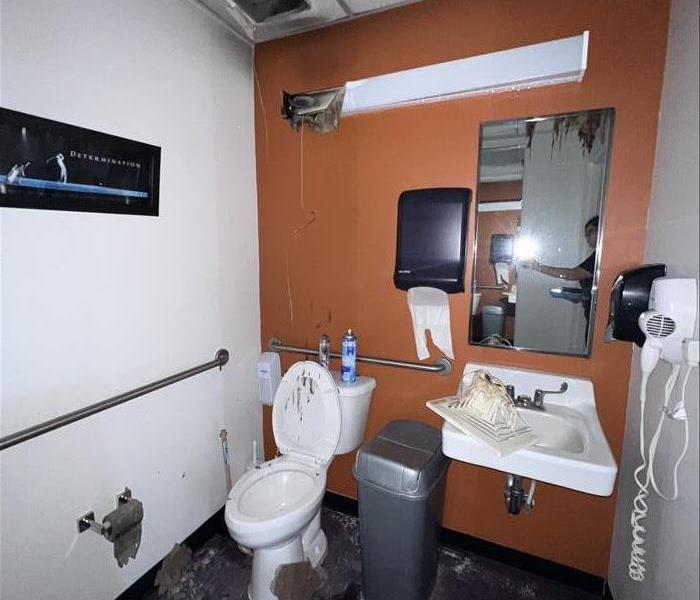 The bathroom lighting fixture caught on fire in this commercial bathroom. This ignited the sprinkler system and caused water damage too.
The bathroom lighting fixture caught on fire in this commercial bathroom. This ignited the sprinkler system and caused water damage too.
Owning a business or managing a property requires proper emergency planning. One disaster, such as a fire or hurricane, can seriously interrupt business or even temporarily close the doors. While natural disasters cannot be controlled, most fires are preventable.
According to data collected and analyzed by the National Fire Protection Association, in 2020 there were 111,000 non-residential structure fires across the United States totaling over $3.4 million dollars in property damages. Non-residential structure fires include fires at hotels, motels, restaurants, educational facilities, retail spaces, office buildings, manufacturing facilities, and other commercial properties. Three common causes of these fires were cooking equipment, electrical and lighting equipment, and heating equipment.
Commercial Cooking Equipment Fires
Commercial cooking equipment fires can be caused by the equipment itself not being properly cleaned or maintained. Always hire a professional to perform maintenance and regularly clean grease from kitchen equipment and vents. Commercial cooking fires are also commonly caused by food being left unattended while cooking. Turn off cooking equipment and remove food from the stove before exiting the kitchen. Unplug small kitchen appliances when not in use.
Commercial Electrical and Lighting Equipment Fires
Old or defective wiring, overloaded circuits, and faulty fuses are just some causes of electrical fires. Electrical equipment should be regularly inspected and maintained by a licensed electrician to prevent fires. If a problem is detected, like a faulty outlet or flickering light, the issue should be addressed immediately. Also, surge protectors are helpful, but be mindful not to overload or misuse them.
Commercial Heating Equipment Fires
Commercial heating equipment includes central HVAC units, boilers, water heaters, fireplaces, as well as other heating appliances. All equipment should be regularly inspected and maintained by a professional to avoid overheating problems. Portable heating equipment, such as space heaters, should be not allowed in commercial properties. If space heaters are allowed, then staff must be warned to only plug them directly into outlets and to turn them off and unplug them when unattended. Never plug space heaters into power strips or surge protectors.
As fire damage restoration professionals, SERVPRO of Greater Covington and Mandeville has restored numerous commercial properties following fire disasters as described above. Most fires can be prevented, but accidents do happen. If a fire event has occurred at your commercial property, our fire damage restoration team will make it “Like it never even happened.” We will work around your operating schedule to avoid business interruption. Call our office to learn more about our fire damage cleaning and restoration services or to schedule an inspection today.
Common Causes of Wintertime Home Fires and How to Prevent Them
1/25/2022 (Permalink)
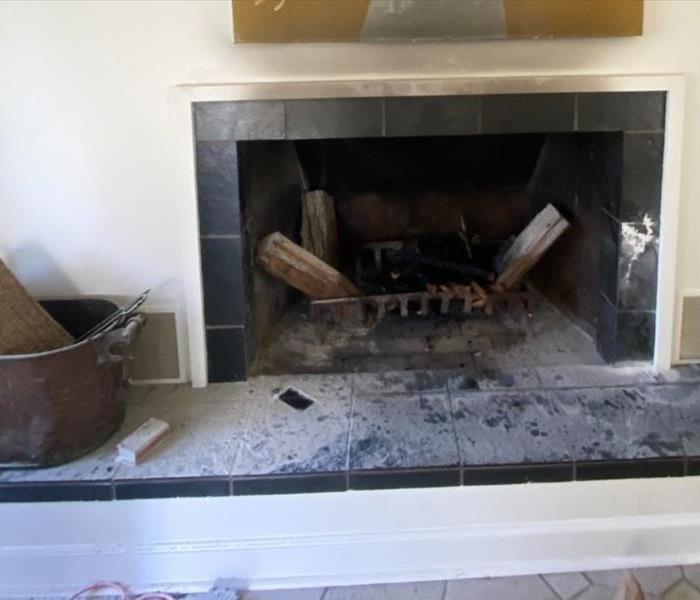 SERVPRO of Greater Covington and Mandeville specializes in cleaning and restoring fire-damaged contents and structures.
SERVPRO of Greater Covington and Mandeville specializes in cleaning and restoring fire-damaged contents and structures.
Home fires during the wintertime are often caused by homeowners attempting to heat their homes. Space heaters and chimneys are usually the sources of these accidents. Follow our fire safety tips below to carefully warm your home and avoid starting a fire this winter.
Fire Safety Tips for Space Heaters
- Only plug space heaters directly into wall outlets. Do not plug into surge protectors or power strips
- Turn space heaters off at night and when you are not home
- Keep space heaters three feet from flammable items like curtains or decorations
- Unplug space heaters when not in use
Fire Safety Tips for Chimneys
- Inspect chimneys once a year, either by yourself or hire a professional. Have the chimney cleaned and repaired when necessary
- Make sure the damper or flue is open before starting a fire
- Inspect chimney for debris, nests, or obstructions each time before starting a fire
- Use dry and well-aged wood to avoid soot buildup
- Place flammable items like decorations at least three feet from the chimney
If a fire does occur, then only attempt to extinguish the fire yourself if it is in the early stages and has not started spreading. Once a fire begins to spread rapidly, it is safer to exit the home and call 911. Do not reenter the home until firefighters and emergency personnel tell you it is safe to do so.
SERVPRO of Greater Covington and Mandeville’s fire restoration team has the knowledge and experience to make a fire disaster “Like it never even happened.” From restoring fire-damaged contents to removing smoke odors, SERVPRO of Greater Covington and Mandeville is here to help 24/7/365.
9 Home Fire Safety Tips for the Holiday Season
12/13/2021 (Permalink)
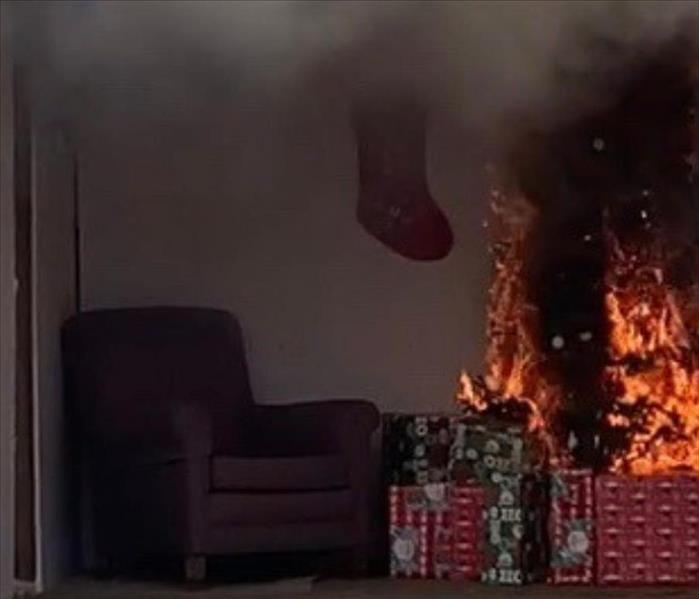 According to NFPA, "between 2015-2019, U.S. fire departments responded to an average of 160 home fires that started with Christmas trees per year."
According to NFPA, "between 2015-2019, U.S. fire departments responded to an average of 160 home fires that started with Christmas trees per year."
Why are home fires more common during the holiday season? Every year we see an increase in home fires during the holiday season due to incidents caused by cooking accidents, dry Christmas trees, and decorations placed too close to heating sources. Christmas Day and Christmas Eve are the two most common days for home cooking fires, preceded by Thanksgiving Day. Also, according to NFPA, “Christmas is the peak day for candle fires with roughly 2.5 times the daily average.” These types of home fires are easily preventable though. Follow our winter holiday fire safety tips below to keep your family and home protected this year.
- Inspect indoor and outdoor holiday lights for frayed wires or broken bulbs. Discard cords with any issues.
- Never leave food cooking on the stove unattended. Keep flammable items like decorations far away from the stove.
- Make sure to water your Christmas tree daily. A dry tree is a major fire danger.
- Test your smoke alarms before the holidays. Replace batteries if necessary.
- Keep candles far away from flammable items and blow them out when exiting a room. Flameless, battery-operated candles are a safe alternative.
- Have your chimney inspected and cleaned before starting your first fire of the season.
- Do not overload surge protectors. This could cause an electrical fire.
- Plug space heaters directly into the outlet. Do not connect space heaters to surge protectors.
- Keep one fire extinguisher near the kitchen and one close by the living room to quickly suppress a fire if necessary.
We wish everyone a safe holiday season. Please share our fire safety tips with your friends and family.
SERVPRO of Greater Covington and Mandeville is a leader in fire and water cleanup and restoration. Our professional fire restoration team is here to help make any size disaster “Like it never even happened,” 24/7/365. For assistance, please contact our office by dialing 985-871-5375.
How to Use a Fire Extinguisher: the PASS Method
8/11/2021 (Permalink)
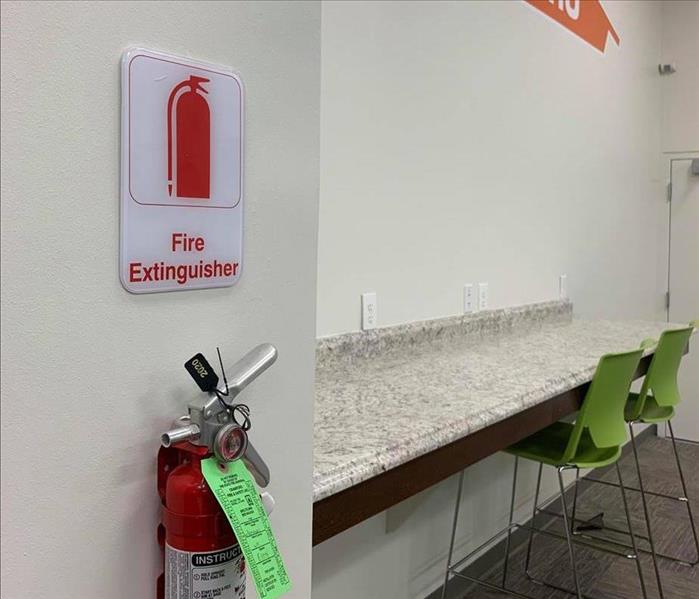 When using a fire extinguisher, remember the acronym PASS - Pull, Aim, Squeeze, and Sweep
When using a fire extinguisher, remember the acronym PASS - Pull, Aim, Squeeze, and Sweep
U.S. fire departments responded to an estimated average of 353,100 home structure fires per year from 2014 to 2018 according to the National Fire Protection Association’s Home Structure Fires report from November 2020. Most of which were caused by cooking, heating equipment, and electrical or lighting issues. Being wholly prepared for a home fire means creating and practicing your fire escape plan, knowing fire safety tips to prevent a fire, and understanding how and when you should use a fire extinguisher to suppress the flames.
The PASS acronym was created to simplify how to safely use a fire extinguisher.
PASS – Pull, Aim, Squeeze & Sweep
Pull – Maintaining control of the nozzle, pull the pin at the top of the extinguisher.
Aim – Stand back from the flames. With one hand, aim the nozzle at the base of the fire.
Squeeze – Firmly squeeze the nozzle with your other hand.
Sweep – Quickly contain the fire by making a sweeping motion with the nozzle.
Only utilize a fire extinguisher on a small fire. Never attempt to suppress a massive fire. If the fire seems too big for a fire extinguisher to suppress, then quickly get outside and call your local fire department for help.
Every home should have fire extinguishers in kitchens, in workspaces or garages, and at least one for each level. Be sure to read the fire extinguisher label to know which class of fire it is meant to put out. And according to firefighterinsiders.com, “you can use a fire extinguisher more than once, as long as it is not damaged or expired, but it must be recharged between uses. It is important to check the label of the fire extinguisher, so you know if the one you have is reusable or not”.
After the fire is extinguished, our team is here to help with cleanup and restoration. SERVPRO of Greater Covington and Mandeville’s fire restoration team has the experience and knowledge to make fire damage not only look “Like it never even happened,” but smell like it too. Contact our office for more information about our fire restoration process.
Insurance Continuing Education Class- Cleaning and Restoring Smoke-Damaged Contents
8/2/2021 (Permalink)
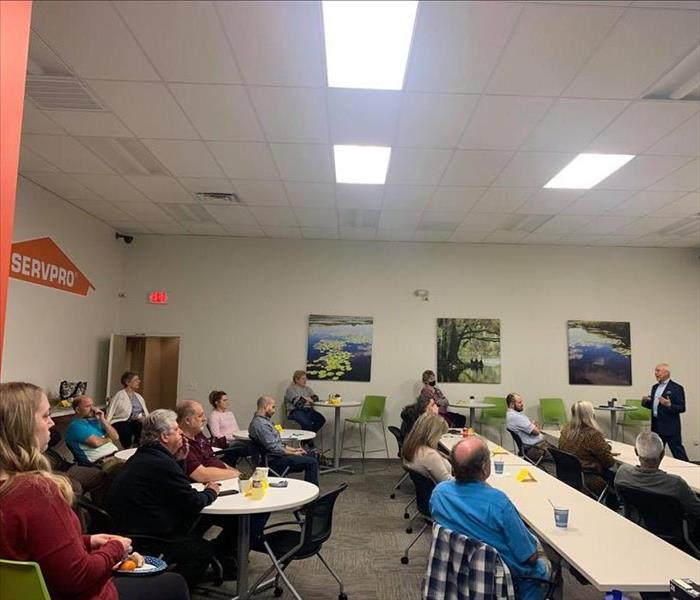 SERVPRO of Greater Covington and Mandeville offers quarterly continuing education classes for local insurance professionals.
SERVPRO of Greater Covington and Mandeville offers quarterly continuing education classes for local insurance professionals.
SERVPRO of Greater Covington and Mandeville is pleased to invite all local insurance agents and adjusters to our upcoming continuing education class - Cleaning and Restoring Smoke-Damaged Contents.
This class explains the different tools used by restoration professionals to clean contents damaged by fire and soot. Insurance professionals can also expect to learn about the various methods and products we utilize for restoration.
This two-hour class will be held at our office located at 68424 James Street in Mandeville on August 26th. Registration will begin at 8:00 am. The class will start at 8:30 am and end promptly at 10:30 am.
We will provide coffee and a light breakfast for all attendees. Please send an email to kayla@SERVPROofcovington.com to learn more and to register.
What's Inside a Fire Extinguisher?
7/12/2021 (Permalink)
In the United States, fires are characterized by five classifications, Classes A, B, C, D, and K. Fire extinguishers are rated based upon the specific fires they are meant to suppress. This is important to note when purchasing a fire extinguisher for your home or business. Which type of fire is most likely to occur at your property? Read the fire class classifications below to determine which fire extinguisher would be helpful in each specific situation.
Class A Fires
- Involve common combustibles such as wood, paper, and cloth
- Should be extinguished with a dry chemical fire extinguisher or a Halotron extinguisher
Class B Fires
- Involve flammable liquid fuels such as oils, grease, gasoline, alcohols, and paint thinner
- Should be extinguished with a dry chemical fire extinguisher
- Do not use water to extinguish this type of fire
Class C Fires
- Electrical fires
- Should be extinguished with a dry chemical fire extinguisher
- Do not use water to extinguish this type of fire
Home fires are commonly Class A, B, or C.
Class A, B, and C dry chemical fire extinguishers are usually filled with either mono ammonium phosphate ( yellow powder) or sodium bicarbonate (white powder). Mono ammonium is corrosive and should be properly cleaned up as soon as possible. Sodium bicarbonate is nontoxic and noncorrosive.
Class D Fires
- Involve combustible metals like magnesium
- Mostly occur in manufacturing and industrial facilities
- Class D fire extinguishers contain powdered metal such as copper, sodium chloride, sand, graphite, or sodium carbonate
Class K Fires
- Cooking fires due to cooking oils or grease
- Should be extinguished with a wet chemicals fire extinguisher
- Mostly occur in commercial kitchens
- Do not use water to extinguish this type of fire
- Class K wet chemical fire extinguishers contain a potassium acetate-based agent which suppresses the fire with soapy foam.
Please read the color-coded label on your fire extinguisher prior to use and always air out a room after using a fire extinguisher. Consult the Safety Data Sheet(SDS) before attempting cleanup. The cleaning method varies for each type of fire extinguisher chemical. Depending on the type of fire extinguisher used and the amount of residue, you may want to leave the cleanup to our experienced fire restoration professionals. While dry chemical fire extinguishers are nontoxic, inhalation of mono ammonium phosphate or sodium bicarbonate can cause health effects. To learn more about fire extinguisher safety visit https://www.poison.org/articles/fire-extinguisher-safety-184.
Please contact our office if you need assistance with fire damage restoration or cleaning up after using a fire extinguisher.
3 Reasons to Choose a Fire & Water Restoration Company vs. a General Contractor to Clean Your Fire Damaged Property
6/11/2021 (Permalink)
Have you recently had a fire at your home or business? The cleaning and restoration process can feel overwhelming. So can understanding the claims process. Choosing a professional restoration company will help alleviate some of your stress and clarify the process for three significant reasons.
We Are Uniquely Experienced
Only after years of cleaning and restoring fire-damaged properties will someone understand the tedious, complex nature of the work. Often, the fire itself does cause most of the damages. After the fire is extinguished, smoke and soot particles travel throughout the property, affecting multiple areas untouched by the flames. The water used to suppress the fire adds another layer of concern too. The wet materials must be assessed and either properly dried or removed. The nature of the fire will also determine which materials can be salvaged and which materials need to be removed. Lastly, the source of the fire plays a major role in the cleaning process. For example, the method for cleaning after protein or grease fires is more labor-intensive than the method for restoring a property after an electrical fire. Our fire restoration team understands how to navigate all these peculiar challenges.
We Utilize Professional Restoration Equipment
As explained above, the fire restoration process includes much more than simply removing fire-damaged materials. The remaining structure must be properly cleaned, dried, and deodorized. Our fire restoration team has an arsenal of SERVPRO proprietary cleaning products to effectively clean any type of fire. To dry the property, we employ our professional moisture detection tools, fans, and dehumidifiers. Most importantly, and sometimes overlooked by general contractors, our fire restoration team understands how to remove the fire and smoke smell from a damaged home or business. Our fire restoration technicians will clean and possibly seal the air ducts, seal the remaining structure after it is cleaned, and thermal fog with a deodorizing product. After our team has completed a fire restoration project, the property should not only look “Like it never even happened,” but also smell like it too.
We Understand the Claims Process
One of the most difficult aspects of handling the aftermath of a fire is often navigating the insurance claims process. Insureds usually have little or no experience managing an insurance claim. Because most of our customers decide to file an insurance claim, our team members are experts at communicating with insurance companies, insurance agents and adjusters, and third-party administrative claims management companies. We advocate for our insureds when necessary to ensure their property is best restored to preloss condition. Our project managers are known for being patient and thoroughly explaining the claims process.
SERVPRO of Greater Covington and Mandeville is proud to be a leader in fire and water cleanup and restoration. Please reach out to our office with any questions about our fire restoration services. We’re always happy to help 24/7/365.
Cleaning and Restoring Fire-Damaged Contents
4/29/2021 (Permalink)
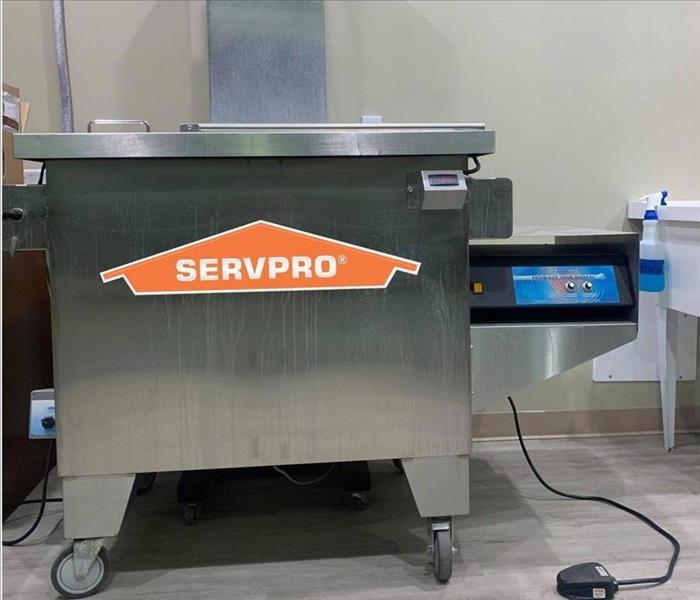 SERVPRO of Greater Covington and Mandeville utilizes an ultrasonic cleaning machine to restore fire and soot damaged contents.
SERVPRO of Greater Covington and Mandeville utilizes an ultrasonic cleaning machine to restore fire and soot damaged contents.
Having a fire in your home is a devastating event. Not only is the structure of your home affected, but your contents may be significantly damaged by fire, soot, or water as well. At SERVPRO of Greater Covington and Mandeville, our fire restoration professionals are extensively trained in various cleaning techniques to save your belongings. We utilize our proprietary cleaning solutions made by SERVPRO chemists and specialized equipment such as the ultrasonic machine pictured here.
This ultrasonic machine employs microscopic bubbles created through cavitation (the formation of bubbles in water) to create vacuum energy in the form of heat and pressure. This process allows the water and cleaning chemicals to reach into the most elusive inner workings of even delicate items. Soot, dirt, and other contaminants are quickly and gently removed. With this machine, we can safely restore a wide range of contents including collectible items, antiques, window blinds, stuffed animals, and toys.
Sound the Alarm. Save a Life.
4/19/2021 (Permalink)
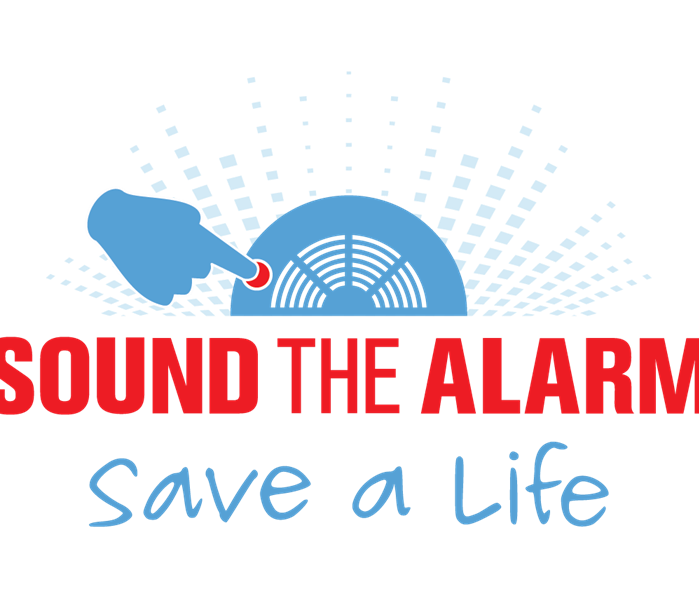 Sound the Alarm. Save a Life.
Sound the Alarm. Save a Life.
Home fires claim seven lives every day, but we can change that. The American Red Cross’s springtime Sound the Alarm campaign runs from April 8th until May 8th this year. Sound the Alarm’s purpose is to educate families about the alarming frequency of home fires and to teach two life-saving tips.
Tip 1: Practice a 2-Minute Fire Drill
- Use this home escape plan worksheet to draw a map of your home and plan your escape routes.
- Each family member should know two exits in each room.
- Practice your 2-minute drill – escape from your home and meet at a safe place
Tip 2: Test Smoke Alarms Monthly
- Press the alarm button on each of your smoke alarms to test if they are working properly.
- If the alarm doesn’t sound, then replace the batteries and test again.
- Replace smoke alarms that are not functioning properly.
- Replace smoke alarms that are more than ten years old.
For more information about the Sound the Alarm campaign or to get involved, visit www.redcross.org/sound-the-alarm.
How Common Are Fires in Apartment Complexes?
4/16/2021 (Permalink)
Fires at apartment complexes occur more often than most people think. In 2020, three apartment complexes in Covington were caught on fire. While the reasons responsible differed, each fire destroyed multiple units. Two of the apartment complexes had to have the entire building demolished due to structural concerns.
According to an article posted on apartmentguide.com, most apartment fires can be attributed to the following five causes- cooking, space heaters, electrical malfunction, arson, and appliances malfunctioning.
Most of these are easily preventable by following these fire safety tips:
- Never leave food cooking on the stove unattended
- Check twice to make sure the stove is turned off before leaving the kitchen
- Store a fire extinguisher in or nearby the kitchen
- Never plug a space heater into a power strip. Only plug them directly into outlets
- Do not overload power strips
- Only smoke in designated smoking areas and properly dispose of cigarettes
- Do not use appliances with frayed wires
- Contact the office or maintenance team immediately if experiencing electrical issues
For more fire safety tips, please visit nfpa.org.
How Soot Varies After a Fire
10/16/2020 (Permalink)
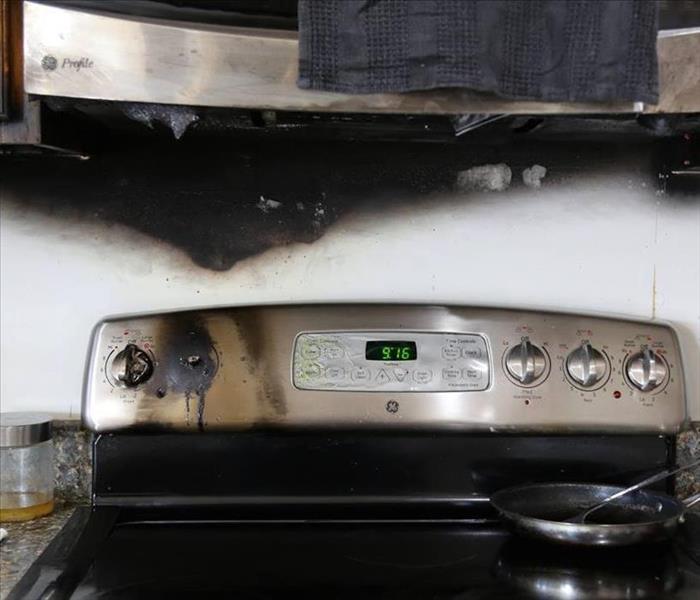 Call SERVPRO of Greater Covington and Mandeville today for all your fire clean up needs.
Call SERVPRO of Greater Covington and Mandeville today for all your fire clean up needs.
What is fire soot?
After a fire has blazed, fine black particles known as soot start to accumulate. When organic, carbon-filled materials burn, some of them do not burn completely. The incomplete burning of materials such as wood, plastic, coal, and oil results in the formation of soot.
During a fire, soot can spread throughout the whole property, attaching too many surfaces and leave a thin black layer of grime. Soot contains forms of acid, metals, soil, and dust. Not only is soot difficult to clean due to its stickiness, if not treated properly it can be destructive to furniture and the building structure. The most common types of soot residues that we encounter when restoring fire damage events are wet soot, dry soot, oily soot, and protein soot.
Types of Soot
Wet soot- This occurs when low heat fires are oxygen-starved. It has high moisture content and can be composed of plastics, rubbers, and oils. It has a very strong smell and can be smeared very easily.
Dry soot- This type of soot is very oxygen-rich which means it occurs when there is a very hot fire. It is composed of natural materials and causes more damage to surfaces than other kinds of soot. The smell is not as harsh as compared to other kinds of soot.
Oily soot- Comes from puff backs and is known to attach to every surface. A puff back is a small explosion inside the burner chamber of your furnace when there is excess fuel that ignites. This causes smoke and soot to shoot into your home. If your gas or oil furnace is not properly maintained, you may be at risk.
Protein soot- When cooking, protein soot can occur and is virtually invisible to the naked eye. Since it is difficult to see, the pungent smell can be a good sign that you have protein soot in your home.
Benefits of Mitigation
As fire restoration professionals, our goal is to mitigate damages and restore your home and contents to their original condition. We believe in restoring rather than replacing as much as possible. Our fire and soot cleaning technicians can help restore antiques, valuables, and many irreplaceable belongings. Some items can be cleaned in your home, while others may need to be brought to our office for more extensive cleaning. We also work with many local specialty restoration professionals that have extensive knowledge in restoring artwork and other sensitive items.
What to Do Before We Arrive
-Do not touch contaminated surfaces.
-Do not attempt to clean walls, carpets, contents, or other contaminated surfaces.
-Do not use affected appliances or electronics.
-Do not use food, cosmetics, or medications exposed to soot.
How We Can Help
When fire strikes, lives are turned upside down. Often, the hardest part for residents and business owners is knowing where to begin and who to contact.
After a fire has damaged your home or business, you do not have to struggle to clean up the affected areas. The professionals at SERVPRO of Greater Covington and Mandeville can assist you to restore your home back to preloss conditions. Our technicians have the specialized tools and expertise required to salvage as much as possible from the aftermath of a fire.
Introducing Our Newest Restoration Tool- The Matterport 3D Camera and Platform
7/16/2020 (Permalink)
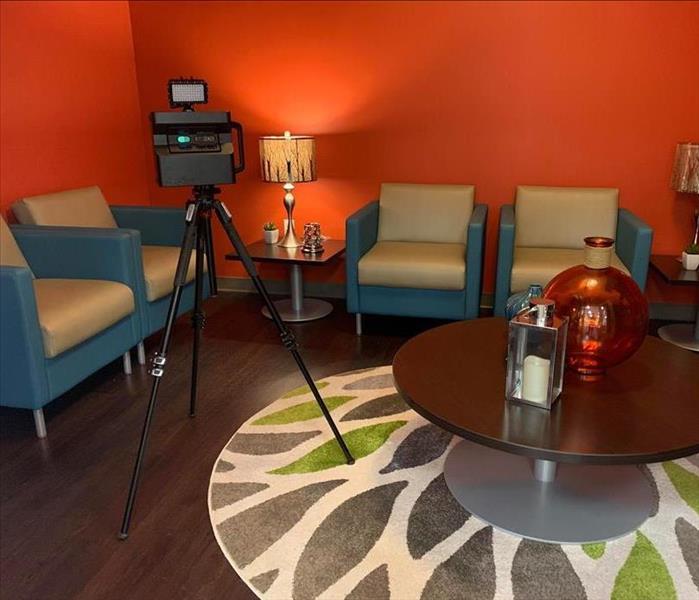 Speeding up the claims process with our latest investment in technology- the Matterport 3D Camera & Platform
Speeding up the claims process with our latest investment in technology- the Matterport 3D Camera & Platform
When a water or fire disaster affects your home, time is of the essence. Mitigation services should begin as soon as possible to prevent future damages. During the initial inspection, our project manager will sketch and scope your home so that the insurance company can understand exactly what your home looks like and which areas were affected. Our newest tool will allow project managers to sketch and scope homes and businesses in a fraction of the time so that our crew can get to work faster. With the Matterport 3D camera and platform, we can create a true-to-life rendering of your property in the most efficient manner possible. This accurate scan will give your insurance company and insurance adjuster a firsthand view of your loss and the damages incurred.
At SERVPRO of Greater Covington and Mandeville, we are committed to investing in our team and the newest technologies to provide the best customer experience. The Matterport 3D camera and platform will help us make any size disaster seem “Like it never even happened,” even faster now!
What are Soot Webs?
5/28/2020 (Permalink)
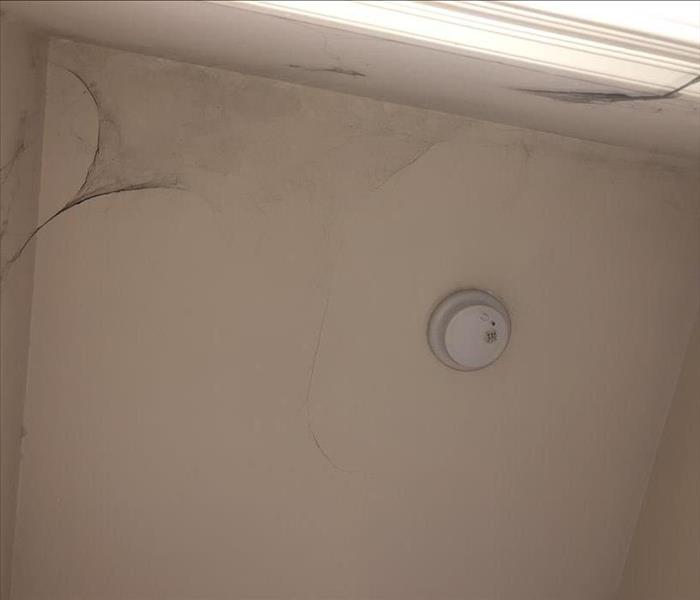 After a fire, soot chains, a.k.a "soot webs", form in cooler areas like edges of walls and ceiling corners.
After a fire, soot chains, a.k.a "soot webs", form in cooler areas like edges of walls and ceiling corners.
The aftermath of a fire is oftentimes more destructive than the fire itself. The remaining contents and structure of your home may be covered with soot particles and drenched with water from firefighters extinguishing the fire. During the initial damage assessment, our fire damage restoration manager will inspect each room to determine how extensive our cleaning and drying processes will need to be.
Our fire damage restoration project manager will test each room for soot particles with a dry sponge and look for soot chains, or “soot webs” as they are commonly called in the restoration industry. While soot chains may resemble spider webs, our professionals can spot the difference right away. Soot chains are ionized soot particles that bond together in cooler areas like edges of walls and ceilings. They must be properly removed to ensure no lingering smoke or fire smell.
Fire damage restoration is a tedious and time-consuming process. Our fire restoration professionals have years of experience and are detail-oriented experts at cleaning fire damaged homes and contents. We understand how stressful it is to recover from a home fire. Our team is here to help walk with you through the claims process and answer all questions you may have.
For assistance contact our office by dialing in 985-871-5375.
3 Tips for Preventing a Fire in and Apartment Complex or Multi-Family Residential Property
3/24/2020 (Permalink)
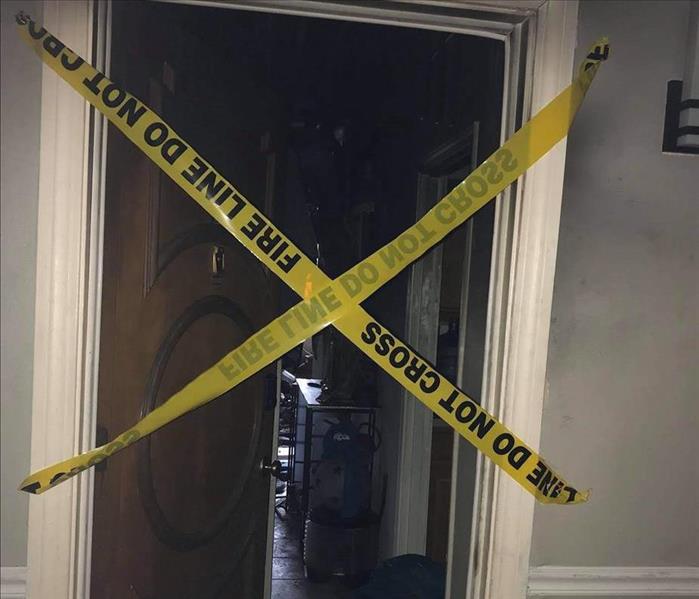 SERVPRO of Greater Covington and Mandeville specializes in fire damage restoration for apartment complexes and multi-family residential properties.
SERVPRO of Greater Covington and Mandeville specializes in fire damage restoration for apartment complexes and multi-family residential properties.
According to the National Fire Protection Association, in 2018 there were 86,500 apartment fires. While this number has significantly decreased from the previous three years that each totaled 95,000 apartment fires, the losses equate to over 1.5 million dollars in property damages and 360 deaths. The modern apartment complex stouts five to ten buildings with three or four floors each. If a single building were to catch on fire, then dozens of families could potentially be affected. Residents renting a unit in an apartment or multi-family residential property like a townhome or duplex should practice fire safety precautions to protect themselves and their neighbors. Property owners and property staff such as property managers, leasing agents, and maintenance crews should also do their part in preventing a fire disaster. Below are a few tips to help safeguard property and people living in multi-family residential properties from fire disasters.
Ensure fire safety equipment is functioning properly
Fire safety equipment includes smoke alarms, fire extinguishers, fire suppression systems.
- Smoke alarms should be tested once a month, the batteries should be replaced once every six months, and alarms should be replaced every ten years. For more information on smoke alarms, watch our video "How and When to Test Smoke Alarms".
- Fire suppression systems (a.k.a. fire sprinkler systems) should be tested on an annual basis according to NFPA code 13.
- Fire extinguishers should be present in every unit and should be easily accessible. Because most residential fires are caused by cooking, having a fire extinguisher in the kitchen is best.
Create and communicate fire escape plans
Residents and staff should be properly prepared for any emergency.
- Give a list of important contacts to each tenant and have one displayed in the main office. The list may include contact information for property after-hours emergency personnel, property managers, the nearest fire department, local police, approved vendors like plumbers, HVAC professionals, and the local restoration professionals-SERVPRO of Greater Covington and Mandeville.
- Each building should have maps identifying fire escape routes clearly marked throughout common areas on each floor.
- Encourage residents to create fire escape plans with their households and practice their plan regularly. In the event of a disaster, everyone should feel prepared to take the appropriate actions, especially young children. Visit our blog for fire safety tips for kids.
Help educate residents about fire safety practices
Most residential fires can be easily avoided by understanding certain dangers and taking extra precautions.
- Since cooking is the number one cause for home fires, remind residents not to leave food cooking on the stove unattended. Turning the burner off when stepping away from the stove can be lifesaving. Any items that could easily catch fire like potholders and grocery bags should be kept away from the stove.
- Candles are a common cause of accidental fires. Encourage residents to blow out candles when exiting a room or to invest in flameless candles.
- Sleeping with the bedroom door closed will slow down the spread of the fire and allow household members to find another way out of the room.
- Never create an open flame or cook on patios or balconies. Only utilize portable cooking equipment in designated areas.
Our team is happy to help any owners and managers of local apartment complexes and multi-family residential properties create an emergency plan tailored to their needs. For more information, please send an email to kayla@SERVPROofcovington.com
For more fire safety resources please visit:
To locate your local fire department visit our blog about testing smoke alarms.
Apartment Complex Fires in Mandeville and Covington
3/3/2020 (Permalink)
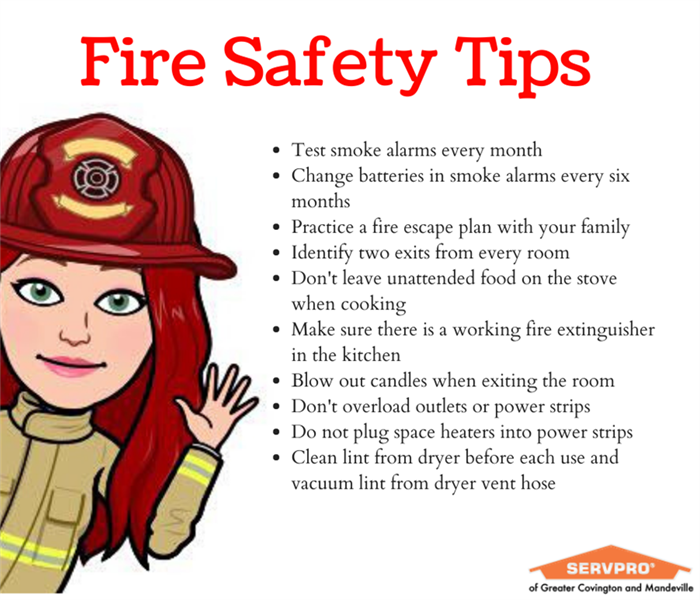 Please practice fire safety tips with your family.
Please practice fire safety tips with your family.
In just a matter of days, there have been two major apartment complex fires on the Northshore, Cypress Lakes Apartments in Mandeville, Louisiana and Maple Ridge Apartments in Covington, Louisiana. The causes of both fires have yet to be determined, but we want to remind the public to practice fire safety. We also want to say thank you to our local fire departments that responded quickly and efficiently to the fires, limiting damages and saving lives.
Fire Safety Tips:
- Make a home fire escape plan and practice it with your family
- Teach children fire safety tips
- Include pets in your fire safety plans and take precautionary measures to prevent pets from starting fires
- Test smoke alarms every month and change the batteries in your smoke alarms once every six months
- Never leave unattended food on the stove when cooking
- Do not overload power strips or outlets
- Do not plug space heaters into power strips
- Blow out candles when exiting the room
- Make sure there is a properly working fire extinguisher in your kitchen
- Do not throw water on a grease fire
- Keep flammable items away from the stove and fireplace
For more fire safety resources, please visit https://www.nfpa.org/Public-Education.
January Employee of the Month
2/5/2020 (Permalink)
 Congratulations to our employee of the month for January, Cicerona!
Congratulations to our employee of the month for January, Cicerona!
Our employee of the month for January is Cicerona! She joined our fire damage restoration team in August of 2017 and has exemplified the spirit of a SERVPRO hero since day one. Cicerona always has a bright smile on her face and works hard to make sure our customers are well taken care of. As a part of our fire damage restoration team, Cicerona is responsible for cleaning and restoring contents that have been damaged by fire, smoke, or soot. She also assists with cleaning fire damages from the structure of a building, including top to bottom cleaning of the inside of property. Her job is extremely tedious and requires a meticulous, conscientious person. We are lucky to have her on our team and are excited to watch her grow.
7 Tips to Keep Your Home Safe While You're on Christmas Vacation
12/16/2019 (Permalink)
Are you planning to visit out of town family this holiday season? While traffic routes or navigating the new Louis Armstrong airport may be top of mind, you should make sure your home will be just the same when you return. Follow our tips listed below to make sure your home stays safe if you're planning on being out of town for more than a couple of days.
- Don't let people know your home is empty. Suspend mail and newspaper services. You can sign up online to suspend USPS mail service and have your mail delivered to a local post office for up to thirty days. For trips longer than thirty days you should ask a neighbor or friend to pick up your mail. Contact your newspaper provider and ask them to temporarily postpone deliveries. You can also arrange for lawn care services while you’re gone for noticeable activity.
- Install exterior lighting or motion detectors to deter burglars.
- Wait to post vacation pictures on social media. This is almost impossible for most people, but you should resist the urge to let the world know you’re not at home. Enjoy the time with your family or friends and post pictures when you return.
- Check the batteries in home security devices, including motion detectors, cameras, and smoke and carbon monoxide detectors. Replace them if necessary. Consider upgrading smoke alarms to home monitoring systems that will notify your local fire department of a fire.
- Shut off the main water supply. Often times a homeowner will call us upon returning from vacation because they have learned a broken pipe or malfunctioning appliance has caused water damages. After you turn off the water main valve you then need to empty the pipes by running water in your sinks and flushing your toilets. If you would like to leave the water on for an automated sprinkler system, then at least turn off the water supply to the dishwasher, washing machine, and to each toilet. You may think this is an uncommon event, but know this happens all too often. You don’t want to come home to a disaster. Save yourself time and money by being just a little overcautious.
- Prevent a power surge by unplugging your electronics or make sure they are plugged into a surge protector.
- Unplug space heaters, candle warmers, outside Christmas lights, and Christmas tree lights when you leave.
Frequently Asked Questions Following a Home Fire
8/19/2019 (Permalink)
We understand the stress and worry a homeowner may feel following a fire event in their home. Our fire damage restoration team has the knowledge and experience to help ease your worries during the restoration process. We do this every day and our purpose is to not only make it "like it never even happened", but also to be a resource for your during the claims process. Below are some frequently asked questions during the beginning of the claims process.
How long will this take?
A complete recovery from a fire event at your home or business can take weeks or months depending on how extensive the damage is. How badly was the property’s structure affected? Does the roof need to be repaired? How much of the structure needs to be removed and replaced? The answers to these questions and several others will determine a clearer project timeline. Before beginning the restoration process, we will give you an estimated project completion date and update you along the way if any changes need to be addressed.
How do you determine what was affected by the fire?
The fire may have been contained to one room in your home or business, but soot can travel via your air conditioning system to several other areas throughout the property. Soot is often hard to detect with the naked eye, but with time acidic soot will lead to discoloration and erosion of materials. Our fire project manager will utilize dry sponges to test areas in your home or business for hard to see soot. Therefore, if soot is discovered in a certain room, then the structure and contents of that room must be cleaned.
How much will this cost? How do you write the estimate?
We use Xactimate to create our estimates. Xactimate is a software program used by all insurance companies for restoration project estimation. The prices for each line item are set within the program and accepted by insurance companies. All estimates include labor, time, and materials required. Again, we will send final estimate and any required supplements directly to your insurance company. The estimation process is exceptionally detailed, tedious, and dependent upon services rendered. That being said, a conclusive estimate can only be completed once the project is finished due to the nature of the restoration process.
What is subrogation?
Subrogation occurs when the insurance company believes a third-party is responsible for the damages and seeks legal action to recover costs for the claim. When subrogation is necessary, the insurance company may not allow anyone to work in the affected area while the investigation is pending. The investigation process may greatly affect our ability to perform services and extend the projected completion date. Our team will have no control over this. Please refer to your insurance company for any questions regarding subrogation.
What should I do now?
If an insurance claim has not already been opened, then calling your insurance company and doing so is the first step. Request a copy of your insurance policy declaration page from your insurance agent or claims specialist to review your coverage. Learn how much coverage you have for structure (labeled dwelling) and for contents. You may need to find another place to stay during the cleaning process. Read your policy or ask your insurance agent to help you understand what is covered under the additional living expenses (ALE) or “loss of use” section in your policy. Ask your insurance company to give you a list in writing of what is commonly covered under these sections. We are not your insurance company and do have any control over your policy limits.
How do I know which items can or cannot be cleaned?
Our fire project manager will help you understand which items are generally able to be cleaned after a fire and which items we suggest discarding of. Some insurance companies may not be willing to pay for our team to create an inventory list of your contents. If your insurance company will not cover the expense of our team inventorying your contents, then we will help instruct you as best as we can. You will want to create a list of all items that need to be discarded and take pictures of each item. Depending on your policy, your insurance company will either pay for the replacement cost of the items or an actual cash value. It will be your responsibility to negotiate an amount for your contents with your insurance company. One tip is to take the list of items needing to be replaced to a large box store and create a registry to show the total of those items.
What is the adjuster’s role in this process?
The adjuster assigned to your claim is working for the insurance company either as an employee or a hired contractor through a third-party claim management company. The adjuster will create an estimate of the needed repairs and your claim will be awarded that amount. We will communicate our restoration plan and share any suggestions or necessary supplements with the adjuster.
Who can help with the rebuild portion of my claim?
Our purpose as your trusted restoration vendor is to clean and/or remove materials affected by the claimed event. We work to mitigate damages to prevent any further damages from occurring in a timely and cost-efficient manner. We are only allowed to remove what is necessary for proper mitigation. Restoration and rebuild are two separate portions of your claim. Following our cleaning process, you will need to hire a contractor to finish repairs. We recommend our partner company Complete Restoration Services and would be happy to have someone contact you with more information.
To learn more about our fire restoration process or for assistance with your home, please send an email to kayla@SERVPROofcovington.com.
Pet Fire Safety
7/15/2019 (Permalink)
Pets are a part of your family and should be included in your family's home fire safety and escape plans. Follow the tips below to help prevent your pets from starting fires and to help protect them during an emergency.
Preventing Fires
The National Fire Protection Association estimates that nearly 1,000 home fires each year are accidentally started by the homeowners' pets. The American Kennel Club and ADT Security Services have joined forces to provide the following tips to help prevent pets from starting fires:
- Extinguish open flames - Pets are generally curious and will investigate cooking appliances, candles, or even a fire in your fireplace. Do not leave your pet unattended around an open flame and make sure to thoroughly extinguish any open flames before leaving your home.
- Remove stove knobs - Be sure to remove stove knobs or protect them with covers before leaving the house - a stove or cooktop is the number one piece of equipment involved in fires started by pets.
- Invest in flameless candles - These candles contain a light bulb rather than an open flame and take the danger out of your pet knocking over a candle. Cats are notorious for starting fires when their tails turn over lit candles.
- Secure young pets - keep them confined away from potential fire-starting hazards when you are away from home such as in crates or behind baby gates in secure areas.
Preparing for a Fire
- Include them in your escape plan - Include your pets in the exercise when practicing your fire escape plan with your family. Practice calling for your pets while existing your home. Teach young children to focus on existing the home as quickly as possible and to never reenter the home to search for a pet. Teach them the firefighters will help search for pets once it is safe to do so.
- Help firefighters help your pets- Put a decal on your home's front window showing the kind and number of pets you have.
- Make sure your pet can be found - During a fire emergency it may be hard to locate your pet if they run off. To prevent your pet from getting lost, make sure their collar has updated information on it. Also, having your pets microchipped will help relocate them if they do become lost. Keep leashes by your front door for easy access as your escaping your home.
- Use smoke alarms connected to emergency responders - Install a smoke alarm that will alert the local fire department in case no one is home.
Dedication Ceremony for Ernest Cooper Memorial Fire Station
6/24/2019 (Permalink)
A brief Dedication Ceremony recognizing the completion of the 2-Bay expansion and the interior renovations at the Ernest J Cooper Memorial Fire Station will be held on Wednesday, June 26th at 10:00 am. Citizens of Covington, area first responders, and the general public are invited to attend. This finished project will provide for better fire protection for our community.
Did you know the Covington Fire Department has one of the best response times in the state of Louisiana and responds to over 1,700 emergency calls each year? Our Covington Fire Department firefighters and administrative staff members spend countless hours teaching fire prevention and fire safety throughout our community. Members of the department also help teach emergency planning for residents and business owners. To contact someone with the Covington Fire Department please visit http://www.covla.com/fire_department/contact_information2.php.
American Red Cross: Pillowcase Project
6/21/2019 (Permalink)
The Pillowcase Project is a program that was developed in New Orleans after college students were seen using pillowcases to carry their belongings during a hurricane emergency. Now the American Red Cross is distributing pillowcases throughout the country and teaching children how to stay safe during emergencies specific to their region and how to respond during a home fire. Through the Pillowcase Project, children will learn how to prepare for an emergency, practice what they have learned, and share this information with their family and friends.
In Louisiana, children taught the Pillowcase Project will learn about preparing for home fires, hurricanes, and tornadoes. Children will learn how to fill their pillowcases with items needed during an emergency, like a flashlight, radio, a change of clothes, medications, and other necessities. An American Red Cross presenter, be it a volunteer or an American Red Cross employee, will also help explain healthy coping skills so that the children can learn how to emotionally process an emergency. Pillowcase Project presentations can be done for a wide variety of groups, such as classrooms, girl or boy scout groups, and church organizations.
To learn more about preparing your child for an emergency please visit https://www.redcross.org/get-help/how-to-prepare-for-emergencies/emergency-preparedness-for-kids.html.
For questions regarding the Pillowcase project please send an email to kayla@SERVPROofcovington.com
NFPA's Most Recent Home Structure Fire Research Report
2/25/2019 (Permalink)
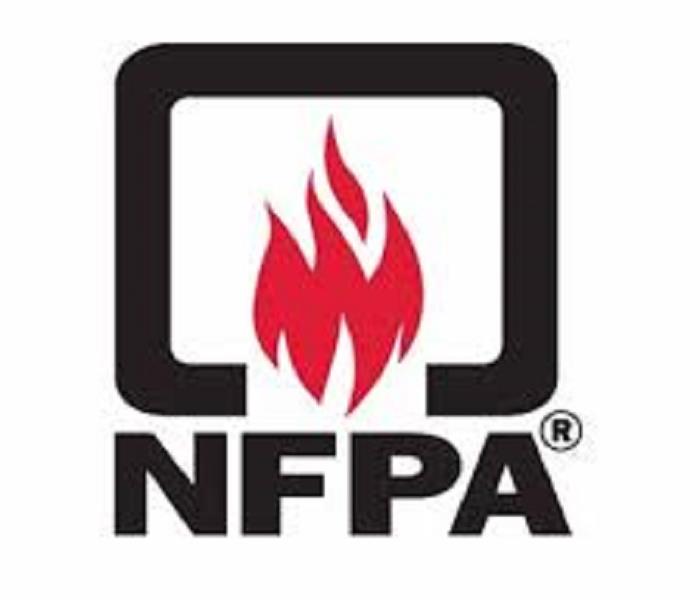 National Fire Protection Agency
National Fire Protection Agency
The National Fire Protection Association (NFPA) is a global nonprofit organization, established in 1896, devoted to eliminating death, injury, property, and economic loss due to fire, electrical, and related hazards. NFPA is a great resource for fire safety tips, fire safety training, and fire research. In December of 2018, NFPA released their most recent research publication of fire statistics and findings from 2012 to 2016. Below are a few important statistics to note:
- More than one-third of reported fires (27%) occurred in the home.
- During this five-year period, firefighters responded to an average of 355,400 fire per year.
- Roughly one of every 326 households per year had a reported home fire during this period. On average, seven people died in a fire in a home per day.
- Leading causes of home structure fires from 2012- 2016 are as follows: Cooking equipment accounted for 48% of home structure fires. Heating equipment accounted for 15% of home structure fires. Electrical distribution and lighting equipment accounted for 10% of home structure fires. Eight percent of the fires were deemed intentional. And lastly, five percent of the home structure fires from 2012-2016 were caused by smoking materials.
- Candles started an average of 8,200 fires annually, resulting in an average of 80 deaths, 770 injuries, and $264 million in direct property damage per year.
- Someone, usually a child, playing fire or another heat source, started an average of 5,700 home fires annually in 2012-2016.
- The kitchen was the leading origin in home structure fires.
- Almost three of every five home fire deaths resulted from fires in which either no smoke alarm was present (40%) or at least one alarm was present but did not operate (17%).
Ways to help protect your home from fire damages:
- Pay attention when cooking. Never leave food cooking on the stove unattended.
- Keep a fire extinguisher in the kitchen. Do not pour water on a grease fire, either use a fire extinguisher or baking soda to put out the fire.
- Do not overload outlets or power strips.
- Do not plug more than one heating appliance into an outlet.
- Make sure flammable items are kept a respectable distance away from the stove, fireplace, and appliances.
- Teach children not to play with fire and other fire safety tips.
- Install smoke alarms on every level of your home and in each bedroom.
- Test smoke alarms every month and replace batteries every six months. Smoke alarms should be replaced every ten years. Check the back of the smoke alarm for the manufacturer's date. If not date is noted, then replace that smoke alarm and install a new one.
- Clean out the lint screen before each drying cycle.
- Unplug appliance when they are not in use.
For more fire safety tips, please visit https://www.redcross.org/get-help/how-to-prepare-for-emergencies/types-of-emergencies/fire.html
Fire Safety Tips for Children
1/23/2019 (Permalink)
Most children learn about fire safety practices in school. Every year local firefighters make special visits to elementary and middle schools in St. Tammany Parish to teach children how to prevent fires and how to respond in case of a fire. But there's more you can be doing at home to help prepare your child for an emergency. Follow the tips below to help practice fire safety with your kids:
Fire Prevention
Children should know that items like candles, matches, and lighters are for adults only. Teach them to notify an adult of any matches or lighters they find out of place.
Test the smoke detector
Have children participate in testing the smoke detectors in your home. Children should know that every month smoke detectors must be checked and that every six months the batteries should be changed. Also, by testing the smoke detector together your child will become familiar with the alarm sound, ensuring they know when a fire has been detected.
Get low and crawl
Teach children to escape during a home fire is to get low on the ground where there is less smoke and crawl to safety. Because fire is scary some children may actually crawl into a closet or hide under their beds during a fire. Teach your child that they must escape to a safe place and not to hide.
Find help
Prepare them to find help after escaping by finding a neighbor and calling 911. Most importantly, teach them that they are not allowed to go back into a burning building under any circumstances.
Stop, drop, and roll
Your child will most likely learn this fire safety tip at school, but you should still spend time going over it with them. The more they practice this tip, the calmer they will be in if their clothes actually did catch on fire.
Practice, practice, practice your escape plan
Usually, children will return from a fire safety class with a fire escape map they have drawn of their home. Go over that map with your child. Make sure they are aware of two exists in each room. Have them draw escape routes and practice escaping a few times each year. Teach them how to determine which route is the best one to take, like testing to see if their bedroom door know is hot.
Children are eager to learn, especially when the information is presented in a fun way. Make games out of practicing these fire safety tips. Maybe you can make children race each other to see who can escape fastest! Also, there are plenty of activities and games for children available at http://www.sparky.org/. And for more information about teaching children fire safety tips please visit https://www.redcross.org/get-help/how-to-prepare-for-emergencies/types-of-emergencies/fire/fire-safety-for-kids.html.
How and When to Test Your Smoke Alarm
10/30/2018 (Permalink)
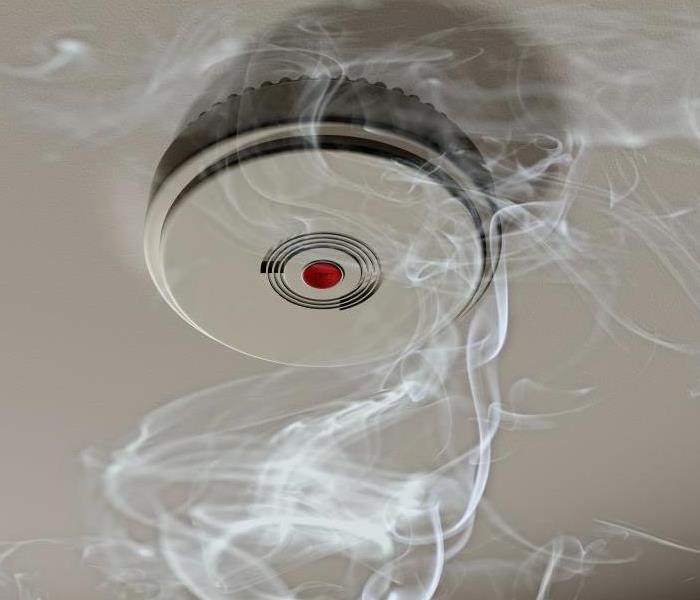 Test smoke alarms once a month
Test smoke alarms once a month
According to the National Fire Protection Agency, U.S. fire departments responded to an average of 358,500 home structure fires per year between 2011 and 2015. Working smoke alarms give an early warning of fire, give people additional time to escape, and thus cut the risk of dying in a reported home fire in half. However, a significant percentage of residential smoke alarms fail to operate during a fire. The two main reasons for a failed smoke alarm detector are simply missing or disconnected batteries and dead batteries. Both cases are easily preventable.
How to Test Your Smoke Alarm
Most smoke alarms have a clearly labeled "test" button. Make a habit to press this button at least once a month to ensure the batteries are properly working. This sound will be loud, but make sure everyone in your family is involved in this exercise to learn what noise to expect in case of an emergency. If the alarm does not sound when tested, then it is time to replace the batteries.
Once you've established that the smoke alarms are properly working, determine if it responds to smoke particles by using a smoke detector test aerosol spray can (be sure to look for one that is UL listed).
When to Test Your Smoke Alarm
You should test your smoke alarms at least once a month to make certain they are operating properly. Another good habit is to change the batteries in your smoke alarms twice each year, once in Spring when we turn the clocks forward an hour and once in Fall when we turn the clocks back an hour. Also, smoke alarms should be replaced every ten years. Dust and debris can settle inside of the alarm and cause the sensors to fail. If you have recently purchased your home, then you should replace all of the smoke alarms unless you can prove the manufacturing date.
Need Assistance With Obtaining Or Installing a Smoke Alarm?
The state of Louisiana supplies each fire station with smoke alarm detectors for the public every year. If you can't afford a smoke alarm or cannot install them by yourself, then please reach out to your local fire department for help. Your local fire department will give and install smoke alarms in your home free of charge as a part of their program Operation Save A Life.
Fire Districts in St. Tammany Parish:
- Fire District 1, Slidell
- Fire District 2 Fire Department, Madisonville
- To contact someone in this fire department call the administrative office at 985-845-3330 or send an email here .
- Fire District 3, Lacombe
- To contact someone in this fire department you can dial 985-882-5977 or send an email to admin@stfd3.com.
- District 4, Mandeville
- St. Tammany Fire Protection District No. 4 encompasses an approximate 70 square mile region on the Northshore of Lake Pontchartrain in Southern Louisiana. The District boundaries are formed by the fourth ward of St. Tammany Parish. It is bordered to the east at Pontchartrain Drive on Highway 190, west to the Tchefuncte River, north to Ponchitalawa Creek (including additional areas along LA Highways 36, 59, Interstate 12, Helenburg Road and the River Oaks subdivision), and south extending 13.4 miles on the Greater New Orleans Expressway (Causeway).
- To contact someone in this fire department dial 985-626-8671 or send an email to contactus@mandevillefire.net
- District 5, Folsom
- To contact someone in this fire department dial 985-796-5266.
- District 6, Covington and North Lee Road Areas
- To contact someone in this fire department dial 985-809-1768.
- City of Covington Fire Department
- To contact someone in this station dial 985-898-4727 or send an email to bnunez@covla.com
- District 8, Abita Springs
- To contact someone in this fire department dial 985-892-2065 or send an email to fd8admin@stfd8.com.
- District 9, Bush
- District 11, Pearl River
- To contact someone in this fire department dial 985-863-3132 or send an email to contact@stfpd11.org.
- Fire District 12
- The District’s boundaries wrap around the City of Covington to the south, east and north, and take in one of West St. Tammany’s busiest corridors – Hwy. 190 between I-12 and Covington. From rural areas north of Covington to the densely populated Tammany Hills and Crestwood subdivisions, FD12 provides service to more than 25,000 people and 1,200 businesses.
- To contact someone at this department dial 985-892-5161 or send an email to info@fd12.org
- District 13, Goodbee Fire Department
Fire Facts and Fire Safety Resources:
Prevent Your Pets from Starting Fires
7/16/2018 (Permalink)
The National Fire Protection Association estimates that nearly 1,000 home fires each year are accidentally started by the homeowners' pets. Just a few months ago we helped restore a home after the homeowners' dog accidentally turned on their gas stove while they were out running errands thus resulting in a small kitchen fire. Thankfully, no one or pets were harmed because of the fire. But now the homeowner knows to remove the kitchen stove knobs to prevent another accident from happening in the future.
The American Kennel Club and ADT Security Services have joined forces to provide the following tips:
- Extinguish Open Flames - Pets are generally curious and will investigate cooking appliances, candles, or even a fire in your fireplace. Ensure your pet is not left unattended around an open flame and make sure to thoroughly extinguish any open flame before leaving your home.
- Remove Stove Knobs - Be sure to remove stove knobs or protect them with covers before leaving the house - a stove or cook top is the number one piece of equipment involved in your pet starting a fire.
- Invest in Flameless Candles - These candles contain a light bulb rather than an open flame, and take the danger out of your pet knocking over a candle. Cats are notorious for starting fires when their tails turn over lit candles.
- Secure Young Pets - keep them confined away from potential fire-starting hazards when you are away from home such as in crates or behind baby gates in secure areas.
Tips for Responding to Fire Damage
6/18/2018 (Permalink)
First and foremost, staying safe is most important. Call the fire department immediately and do not enter the property until it is okay to do so.
After a fire, the damage left behind by the water used to extinguish the fire and the lingering soot are often worse than the fire itself. SERVPRO of Greater Covington and Mandeville has many years of experience in cleaning and restoring fire damaged properties. We work hard to make it seem "Like it never even happened."
What to do after a fire:
- Limit movement in the home to prevent further damage
- Place dry, colorfast towels or old linens on carpeted traffic areas to prevent more soiling
- If electricity is off, empty freezer and refrigerator and prop open doors
- Do not attempt wash any walls of painted surfaces
- Do not attempt to shampoo carpet or upholstered furniture
- Do not attempt to clean any electrical appliances that may have been close to fire or water
- Call SERVPRO of Greater Covington and Mandeville at 985-871-5375
Why every family should create a home inventory list
6/18/2018 (Permalink)
In the unfortunate event of an emergency would you be able to list the contents of your home for your insurance company? How much is your home truly worth? What is the current value of your furniture, artwork, jewelry, kitchen appliances, etc?
Creating a household inventory list will help to prove your losses after a disaster, like a fire or a catastrophic hurricane. A detailed inventory of your home includes careful descriptions of each valuable item, receipts, and pictures. Copies of the list should be stored in a fire proof safe, shared with a family member, and sent to your insurance agent. You can even go paperless and download a free App to make your list. For more information about home inventory lists visit www.rmiia.org or www.howtogeek.com.
How Much of Your Belongings can You Save After a Fire?
2/20/2018 (Permalink)
According to the National Fire Protection Association, over five hundred thousand structure fires devastated homes and businesses in the United States in 2015. These losses account for more than ten billion dollars in property damage costs.
After the fire, the home or business owner's remains are left covered in soot. Acidic soot will cause even more harm to belongings. Thankfully, some items can be restored with the help of our professional fire damage restoration technicians. SERVPRO of Greater Covington and Mandeville specializes in structural cleaning, contents cleaning, and deodorization. We are open 24/7 to respond to any disaster. Give us a call after a fire and we will work to make your house a home again.
For more information on fire damage in the U.S. visit http://www.nfpa.org/
Fire Restoration Process
1/22/2018 (Permalink)
The fire restoration process is very detailed and time consuming. However, the process can be simply broken down into three main steps:
- Assess Situation- We identify what can or can not be salvaged. With the approval of insurance adjuster and client, we discard of certain materials. We test for smoke damage on structure and contents.
- Pretest and Clean-Utilizing professional products and tools we pretest and clean both contents and structure, removing soot damage. Air ducts will be cleaned of soot damage as well.
- Deodorize-After structure has been cleaned properly, we deodorize the property using a thermal fogger.
SERVPRO of Greater Covington and Mandeville specializes in fire and soot damage restoration for both commercial and residential properties. If your home or business has incurred fire or soot damage, please give us a call today at 985-871-5375.
How to Create a Fire Escape Plan for Your Family
1/15/2018 (Permalink)
According to the National Fire Protection Association, there were 1,342,000 fires in the United States in 2016, of which 475,500 were structure fires. One home structure fire was reported every ninety seconds. Most businesses have fire escape plans to help saves lives during an emergency. Creating a fire escape plan for the home should be just as common, especially for families with young children or with special needs family members. Being prepared saves lives during an emergency.
Thankfully, NFPA has created an easy how to guide for creating a home fire escape plan:
- Draw a map of your home. Show all windows and doors.
- Visit each room and recognize two ways out.
- All windows and doors should open easily. You should be able to use them to get outside.
- Make sure your home has smoke alarms. Test your alarms regularly.
- Pick a meeting place for when you must evacuate. The meeting place should be in front of the home.
- Make sure your house or building number can be seen from the street.
- Talk about the plan with everyone in your home.
- Learn the emergency phone number for your local fire department.
Most importantly, practice the plan with everyone in your home. This can be a fun exercise for children. Have them draw a map of your home and color all the possible escape routes. Once or twice a year go over the plan with everyone in the home again.
To learn more about fire safety in the home please click here.
Fire Safety Tips For The Holidays
11/22/2017 (Permalink)
'Tis the season to bask in holiday cheer and enjoy visiting with your family and friends. This time of year we love to decorate our homes and offices to brighten our lives. However, some of these decorations present major fire hazards. According to NFPA, the National Fire Protection Association, "between 2010-2014, U.S. fire departments responded to an average of 210 home fires that started with Christmas trees each year" and between 2009-2013 Christmas decorations started an average of 860 home structure fire each year. You can prevent fires of this nature by being a little more mindful around your home. Please take note of these simple tips to help keep you, your family and your friends safe this holiday season.
Be mindful in the kitchen
Most holiday season home fires start in the kitchen. You should never leave food cooking on the stove unattended. Ask someone to watch over the food if you need to leave the kitchen for a moment or take a pot holder with you to remind you to head back to the kitchen soon.
Check that your smoke detectors are working properly and make sure you have a fire extinguisher near the kitchen.
Be mindful of your Christmas trees
A well watered Christmas tree is almost impossible to ignite. You should check the water level every day.
Keep your Christmas tree at least three feet away from any source of heat, like fire places, space heaters, heat vents, or candles.
Be mindful of your Christmas lights
Before decorating your tree with lights, inspect the lights. If you notice any cracked or frayed wires, then throw them away.
Avoid using nails or staples when hanging lights outside. You should use clips or hangers to prevent damaging the wiring.
You should also read the manufacturer's instructions for the allowed number of light strands to connect.
Be mindful of your candles
The top four days for fires caused by candles are Christmas Eve, Christmas Day, New Year's Eve, and New Year's Day.
Keep candles at least one foot away from anything that can burn and make sure to put them out before leaving the house or going to bed.
Also, do not let children play with matches or attempt to light candles themselves.
Be mindful of your fireplace
Have your fireplace cleaned, if needed, before starting any fires this year.
Always screen the fireplace to prevent embers from popping out.
To learn more about fire safety tips click here.
Why choose SERVPRO of Greater Covington and Mandeville?
2/20/2017 (Permalink)
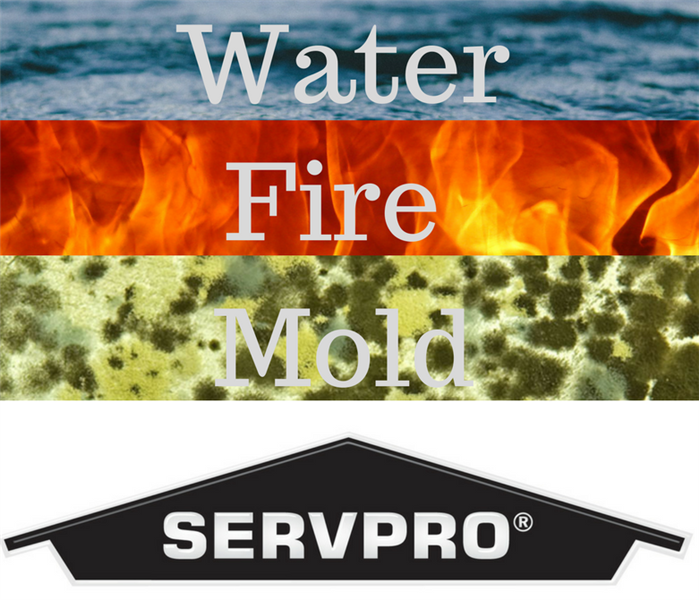 Cleanup & Restoration
Cleanup & Restoration
SERVPRO of Greater Covington and Mandeville is independently owned and operated and has been helping this community since 2009. We are open 24/7/365. Within one hour of notice of loss, we will contact you to arrange for service. Within four hours of notification of a loss, our SERVPRO professionals will be on-site to start mitigation services. Within eight business hours of on-site arrival, a verbal briefing of the scope will by communicated. We are IICRC certified and employ professional, knowledgeable technicians. Whether you have water, fire or mold damage we can help mitigate your losses and quickly restore your home or business back to preloss condition. We also specialize in crime scene cleanup, bio hazard cleanup, deodorization, air duct cleaning, reconstruction and much more. We are here to help you with any size disaster. You can give us a call anytime at 985-871-5375 for help with an emergency.






 24/7 Emergency Service
24/7 Emergency Service












